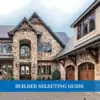We understand that starting a custom homebuilding project can raise many questions. Below, you’ll find answers to the questions we receive most frequently, ensuring a smooth and transparent experience while planning your custom home. Contact us today if you have a question that’s not covered here.
Frequently Asked Questions for Custom Homebuilders
A: When you work with Ridgeline, the first step in your homebuilding journey is a thorough site evaluation. This ensures that you find the perfect lot for your dream custom home, tailored to your lifestyle and vision.
From there, our team collaborates with you and an architect to design a home that meets your needs and maximizes your chosen lot’s potential. Whether you’re starting from scratch or already have architectural plans, we provide comprehensive guidance to bring your vision to life with precision and expertise.
A: Full-clad windows provide outstanding durability, energy efficiency, and a classic look, perfect for those who value long-lasting quality and style. Aluminum-clad windows offer a more affordable alternative that’s easy to maintain, making them great for homeowners who prioritize practicality without compromising on quality.
A: Both site-finished and prefinished hardwoods offer distinct advantages, depending on your needs. Site-finished hardwoods provide greater customization options, including a wider array of colors and the ability to refinish multiple times, making them ideal for a personalized touch.
Prefinished hardwoods, on the other hand, come with specialized finishes and unique textures like wire-brushed or hand-scraped, offering a more convenient and quicker installation process. Both types can be refinished, depending on the product chosen. Ultimately, the decision comes down to the style, texture, and convenience that best suits your custom home.
A: Natural quartzite is currently a top choice among our clients, favored for its stunning marble-like appearance and exceptional durability, making it ideal for high-traffic areas like busy kitchens.
Soapstone is also gaining popularity for its unique rustic charm, as it develops a smooth patina over time and is naturally resistant to heat and bacteria. Concrete countertops are trending for their industrial-chic aesthetic, though they do require regular sealing to prevent staining and maintain their appearance due to their porous nature.
A: Not entirely! While many homeowners are now gravitating towards more practical options like natural quartzite, marble remains a top countertop choice in luxury kitchens, adding elegance and sophistication to any home.
If you’re considering marble, it’s worth exploring options with added protection to ensure your investment continues to shine. Fortunately, there are now products available with warranties against staining and etching, offering additional peace of mind.
A: Inset cabinets feature doors that sit flush within the frame, offering a traditional and precise look with hidden hinges for a sleek finish. However, they are generally more expensive due to the labor and precision required for their construction. Inset cabinets may also require more maintenance to keep the doors properly aligned.
Overlay cabinets, on the other hand, have doors that overlap the frame, providing a modern appearance and more usable space within the cabinet box. They are easier to install and adjust, making them a more budget-friendly option with less maintenance required.
A: The height of your cabinets depends on your ceiling height and the style you choose. For standard configurations, base cabinets are typically 36 inches tall, while bar-height counters are around 42 inches tall.
For upper or tower cabinets, the standard height is 8 feet. However, many clients choose to extend the cabinets 10 to 11 feet to the ceiling for additional storage and a more streamlined look.
In spaces with vaulted ceilings, cabinets can be extended up to the spring point of the vault to make the most of the vertical space. Tower cabinets, which are deeper at 26 inches, should also be adjusted to fit seamlessly into the overall design.
A: Pizza ovens can be a fantastic addition to your outdoor kitchen, adding a fun and interactive element to your gatherings. Plus, they aren’t limited to pizza alone and can be used to cook various other dishes. They are available in wood burning or gas (natural or propane) depending on your home site’s utilities.
However, cooking with pizza ovens requires skill and practice, and there are ongoing costs associated with maintenance and fuel. Depending on your needs and preferences, a regular oven may suffice for similar cooking tasks.
A: To minimize grout maintenance, consider using epoxy grout, which is more stain-resistant than traditional grout. Regular sealing of the grout can help prevent stains and mildew buildup. Avoid using harsh cleaning agents or bleach, as these can damage the grout.
Instead, after showers, use a squeegee to remove excess water and wipe down the grout weekly with a damp cloth to prevent soap buildup. These simple steps will help maintain your grout and keep it looking clean with less effort.
A: Masonry fireplaces bring a timeless charm and can be customized to any size or style, including unique options like the Rumford firebox, which is often preferred by architects. While they offer extensive personalization, they typically come with higher costs, longer installation times, and more maintenance.
Isokern fireplaces provide a clean, minimalist design with easier installation and maintenance. They come in fixed sizes, which may limit customization compared to masonry options.
A: When choosing a kitchen sink, you have various material options based on your lifestyle and style preference, including enameled cast iron, concrete, composite, fireclay, and stainless steel. For a classic look with practical benefits, farmhouse sinks are an excellent choice, as their deep basins are perfect for handling large pots and pans.
If you prefer a sleek, contemporary appearance, undermount sinks provide a minimalist look and are easy to clean. Fireclay sinks, known for their durability against chipping and scratches, are available in a variety of colors and finishes and offer a transitional appeal. For a more rustic look, consider sinks made from hammered copper or concrete.
Additionally, consider the basin depth and configuration. The ideal depth today is typically 9″-10″, and you can choose between single or double bowls. If you opt for a double bowl, decide if you want a full-height divider or a low divider to accommodate larger items like cooking sheets.
A: Gas fixtures provide a warm, ambient glow and are known for their continuous operation, as it’s generally less expensive to keep them running than to use an electronic ignition. They are ideal for creating a classic, inviting atmosphere.
Electric fixtures offer a wide variety of styles and energy-efficient LED options, allowing for greater flexibility in color temperature and overall aesthetic. With numerous choices available, you can easily find an electric light fixture that meets your design preferences.
A: A car lift maximizes parking space by storing vehicles vertically, but it requires structural reinforcement and ample ceiling clearance.
Installing a car charger promotes sustainability and convenience for electric vehicles. It can also significantly boost your home’s resale value. Consulting with our qualified contractors can help tailor these enhancements to your specific requirements.
A: Many of our clients seek sustainable landscaping solutions that prioritize water conservation and native plant species. They also enjoy outdoor living spaces like fire pits and seating areas, enhancing functionality and creating inviting gathering spots.
Low-maintenance designs with drought-resistant plants and automated irrigation systems are in demand, saving time and resources while maintaining a lush landscape.
A: In-home pools offer endless recreation and entertainment opportunities, providing a space for leisure and socializing and promoting health and fitness. However, they come with a high initial cost, ongoing maintenance requirements, safety concerns, and limited seasonal use.
Plus, homeowners’ associations may impose restrictions and responsibilities, adding another factor to consider. Consult with the professionals at Ridgeline to determine if an in-home pool aligns with your preferences and priorities.
A: Decorative HVAC vents, including options like linear diffusers, laser-cut designs, and flush plaster or drywall integrations, can significantly enhance the visual appeal of your space and complement your home’s decor. These fixtures can elevate the overall look of your interior and potentially add value to your home.
However, it’s important to consider that decorative vents can come with higher costs and may sometimes impact airflow efficiency. Before investing, it’s a good idea to consult a professional to evaluate how these designs might affect your HVAC system’s performance.








